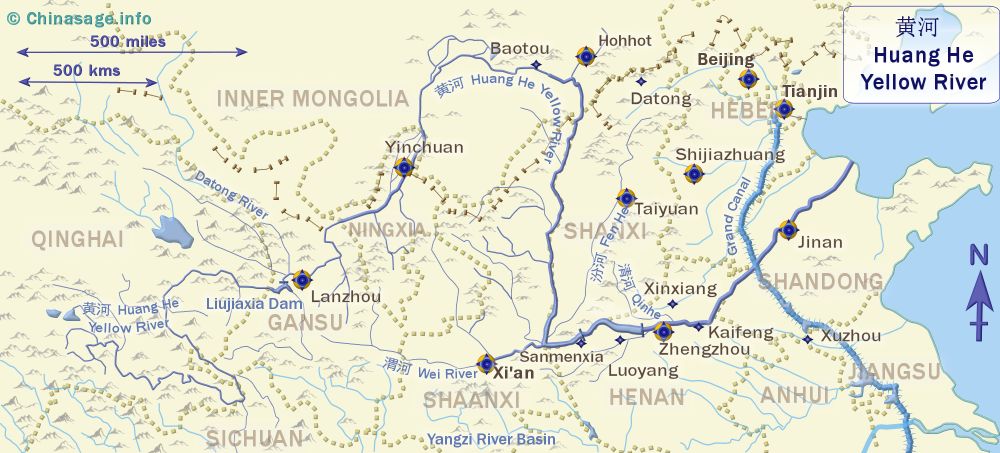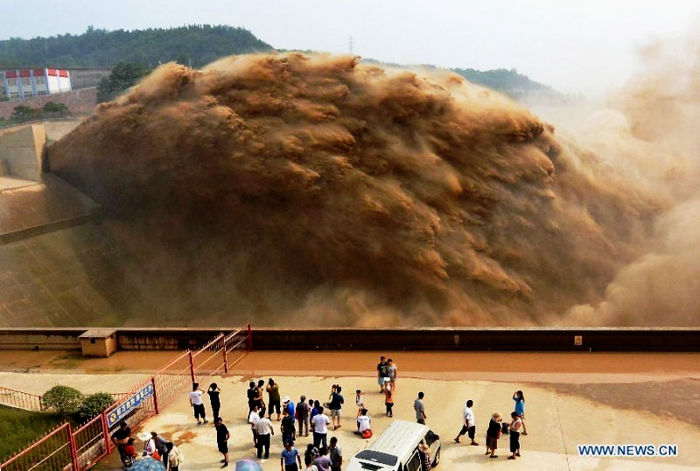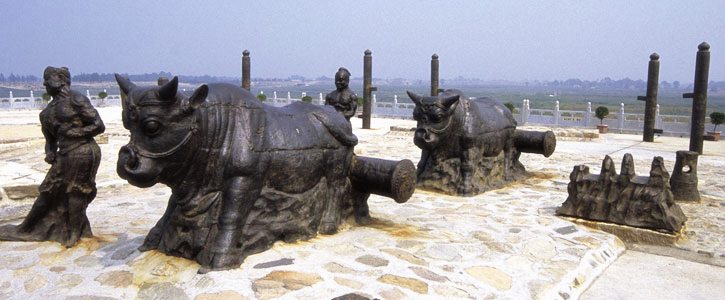The Yellow River - Huáng Hé 黄河


The Yellow River (黄河 Huáng Hé ) Hwang Ho WG) is at the heart of China, both historically and geographically. It is the second longest river in China after the Yangzi 3,400 miles [5,472 kms]. Rising in western Qinghai province close to the source of the Yangzi at 13,000 feet [3,962 meters] it heads north-east over the mountains to Lanzhou, Gansu the ancient gateway city of China. Turning north into the dry Gobi desert it irrigates the ancient city of Yinchuan, Ningxia before taking a long loop around Shaanxi province picking up its heavy load of loess silt along the way. Here the river has eroded a deep channel through the hundreds of feet of loose earth. It then turns north-east between Shanxi and Henan to reach the sea in northern Shandong.
Yellow comes from the color of the river's waters, for the river carries a heavy load of silt (loess called Yellow Earth (黄土 huáng tǔ in Chinese) picked up from an extensive plateau in Shaanxi, Shanxi and Gansu. It is perhaps the muddiest major river in the world, not only due to the silt but because of evaporation and water usage in its lower half. The river can carry as much as 82 pounds [37 kgs] for every cubic meter of water. In some summers the river loses so much water that it never reaches the sea. This heavy load of silt is both a great bonus and a curse. Like the lower Nile where the regular deposition of rich alluvial silts gave birth to the Egyptian civilization, the Yellow River valley was the cradle for the creation of Chinese civilization. The settlers who farmed the rich alluvial covered lands close to the river produced regular good harvests which gave them an advantage over wandering herdsmen and hunters. In the upper stretches, the water melted from far away glaciers producing a steady, reliable flow throughout the year. The control of the river for irrigation was made possible by many technological innovations. In the Spring and Autumn period separate kingdoms had to co-operate in order to manage the waters, which was a great spur to cultural development. It is said that the coordinated mass effort needed to tame the Yellow River is the very reason that a strong central government was needed in China. The most famous legendary figure associated with the taming of the river is Yu the Great.

Why Yellow?
It was only after the Han dynasty that it was called the ‘Yellow River’ previously just ‘The River’ would do. May be, in these days the land was rich in forests and it is the man made clearance of forest and farming methods that has greatly increased the loess ➚ load that the river transports and so its color had changed to yellow. The Chinese character for yellow is 黄 huáng based on a picture of a precious object - a Jade pendant. Yellow or perhaps a better translation ‘golden’ has been the color of Emperor's robes since the Tang dynasty and the name of the legendary Yellow Emperor (黄帝 huáng dì) the founder of China. The river and its color has been very important to the development of Chinese culture.
The provinces of Hebei and Henan are named after the river (their names literally mean ‘river north’ and ‘river south’). The low flow rate of the lower stretches of the Yellow River make it difficult to navigate as it is so shallow; it has never been able to transport large quantities of goods. In contrast the Yangzi has a much great flow of water.

China's Sorrow (中国的痛 Zhōng guó de tòng)
The curse of the river is that the high load of sediment is often deposited in huge banks, silting up the river. The river banks gradually build up and eventually block the water flow, causing floods as the river seeks a new course. Beyond Kaifeng the river was too difficult to tame, the channel to the sea changed frequently over the centuries, in all 26 times in 3,000 years, most recently in 1853. In the Western Han dynasty it changed course twice in only six years. The god of the Yellow River was called He Bo 河伯 . To appease the river god a human sacrifice was made every year up until the end of the Zhou dynasty; a beautiful girl was chosen and she was shackled to a marriage bed that was set upon the waters. For many centuries it was considered unlucky to rescue a person from drowning in a river as it would anger the god by removing the 'gift'. To guarantee a safe crossing everyone made an offering to the god usually in the form of a jade ring. In 30BCE fears of a flood led to the creation of a sculpture of a gray horse decorated with jade emblems to offer to the waters. This attempt did not lower the level of the river and the local population fled to higher ground. The shamans held their ground, reciting their incantation and at last the flood started to abate and the governor was richly rewarded.
One of the most famous pieces of Chinese music written in the western classical style is the Yellow River Piano Concerto ➚ 黄河协奏曲 Huáng hé xié zòu qǔ premiered in 1969 and promoted by Jiang Qing. It has revolutionary and nationalist themes set in four movements.
Yellow River Floods
Devastating floods occurred in 1931 ➚ (about 2,000,000 deaths) and 1887 ➚ (about 1,500,000 deaths). Detailed records of the floods and flood defenses go back over 4,000 years. The flood of 1841 was particularly hard - submerging and destroying much of the former Imperial capital Kaifeng. It took four years for the flood defenses to be rebuilt at great expense. The flood in 1938 ➚ (about 800,000 deaths) was deliberately caused by Chiang Kaishek in an attempt to hold back the Japanese occupation of China. This event was an historical echo of the flood in 1642 ➚ when the governor of Kaifeng broke the banks of the Yellow River to break the siege of rebel leader Li Zicheng causing about 300,000 deaths. Other nicknames include the ‘Ungovernable’ and ‘Scourge of the sons of Han’. The floods make it by far the world's most deadly river. From this sad history the poetic name for the Yellow River - ‘China's Sorrow’ can be appreciated.
Sometimes the river has reached the sea much further south, even as far as Jiangsu province to the south of Shandong. The river is now entombed in towering man-made levees running 33 feet [10 meters] above the level of the plain. The defenses need continuous maintenance and re-modeling as the silt builds up in the channel high above, if the river flowing high above bursts its levee then widespread flooding would be inevitable.

The dangerous and meandering course of the Yellow River has made it unwise to build cities close to its banks on its lower stretches. Chang'an an ancient capital of China at present day Xi'an is built on the Wei River a tributary and not on the Huang He itself, only Kaifeng has been built close to its perilous waters. Over the centuries various schemes have been proposed to control the flow. As far back as the beginning of the Han dynasty - over two thousand years ago - a canal was built to avoid the treacherous rapids near Sanmenxia. These vary from straitjacketing the river to flow on a new course to iron out minor deviations of flow direction. The Daoist strand of philosophy suggests that ‘bending’ to accommodate rather than ‘blocking’ and indeed the measures that ‘go with the flow’ have always been more successful. There are continued initiatives to reforest the loess plateau upstream to stabilize the loose soil and prevent flash flooding but about 65% of the land is still eroding.
Sanmenxia Dam
After the formation of the PRC in 1949 a strategic flood defense plan was drawn up with Russian help. A large dam at Sanmenxia (on the Shanxi-Henan border) was completed in 1960 with the aim of controlling floods and generating electric power. It also became a political message of the new government - it was to tame nature for human benefit. However, as many Chinese engineers had warned, the dam soon silted up. Remedial work was needed in 1964 to re-engineer the outflows. This work also failed and the dam now causes flooding of the Wei River. Sanmexia has limited flood defense potential and generates only 25MW of electricity (about 5% of its intended power). Much further upstream, the dam at Luijiaxia above Lanzhou is in clearer water and has been more successful. It's often more modest water management schemes that give more benefit than huge, high profile ones.

Xiaolangdi Dam
To provide the necessary river control a new dam was needed further downstream from Sanmenxia. The concept was approved in 1991 and construction was completed in January 2001. It generates hydro-electric power (up to 5 billion KWh) from six huge turbines. However the river flow is not always adequate to drive it at full power. The problem of silt build up has been solved by an annual high pressure venting of water over a ten day period in June/July. This flushes out all the silt accumulating behind the dam. The regulation of water and silt flow has reduced the need for constant maintenance of the lower Yellow River defenses. It has proven much more successful than Sanmenxia and adequately controls the waters, making a flood of Henan and Shandong only likely to occur once every few centuries rather than every few decades.
Pujin Bridge

One of the great marvels of Tang dynasty engineering was the construction of a bridge in 724CE over the Yellow River at Pujin. It linked Shaanxi and Shanxi provinces, and with the Chinese capital located not far away at Chang'an (Xi'an) it was an important crossing near the eastward bend in the river.
Emperor Xuanzong had become exasperated by the destructive force of the great river as it washed away many wooden pontoon bridges that had been built over the centuries. He decided to solve the problem with a more ambitious bridge made of iron. Chinese iron technology was far ahead of that of the west. The Pujin bridge took the form of wooden planks affixed to giant iron chains over the river. The chains were anchored securely in huge iron oxen sculptures on the banks. On the back of each ox was a rod to which the chains were attached.
About one third of China's annual iron production went into this project. Each region had to send iron ore to the capital where giant furnaces converted it to cast iron. There were eight oxen, each about 10 feet [3 meters] long and 5 feet [2 meters] high. They weighed about 70 tons [63,503 kgs] each and were cast as a single piece - an amazing achievement for the time. Not only were the oxen of monumental size but they were anatomically accurate figures of oxen. Oxen were chosen because the animal is believed to have the power to control floods. This is from the system of Five Elements where the ox represents the earth element that controls the water element. Leading the teams of oxen are four figures; one representing each major ethnic race in China at the time: Uyghurs , Mongols, Zangs and Han Chinese.
Although the construction was well documented in the official writings of the time, the Pujin bridge was lost in floods after only a few hundred years and was only rediscovered in 1989. Four oxen and cast iron handlers can now be seen at a museum at Yongli south-western Shanxi.
Replenishing the River
The Yellow River is heavily used by people along its route and on occasions it dries up before reaching the sea. This is likely to accelerate with climate change. In 1997 the great Yellow River stopped flowing 404 miles [650 kms] before its normal outlet to the sea for a total of 226 days. For many years water has been abstracted from deep underground, but this can only be a temporary solution, the only real answer is to bring water from the far wetter south. There are three separate and huge south to north ➚ water diversion projects. One is in the Yellow River's headwaters on the Qinghai-Sichuan border that requires tunneling through mountains. The second (middle) route heads north through Hubei and the last one follows the course of the old Grand Canal over its abandoned section. The total cost will be over three times that of the Three Gorges Dam on the Yangzi. With a shortage of pure water suitable for drinking (only 25% of all water considered safely drinkable [potable]) there are many initiatives to clean up the water at a local level.